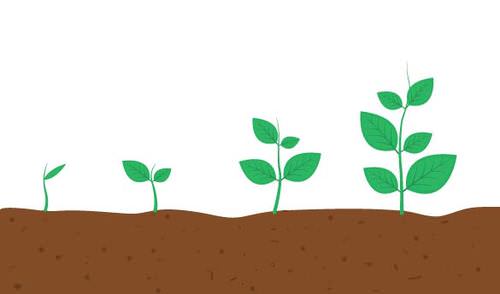6.20 人口增长模式
章节大纲
-
What you will learn
::你会学到什么-
What are the different patterns of
::不同的模式是什么? -
Types of
based on the pattern of population growth
::基于人口增长模式的各类
What starts out very small and has the potential to grow considerably larger?
::什么起点很小,而且有长得大得多的潜力?Trees, of course. But also . Give a population everything it needs to survive, and the growth of that population will be tremendous.
::当然,树木,当然,但是,也给人们生存所需的一切, 人口的增长将是巨大的。Patterns of Population Growth
::人口增长模式Populations may show different patterns of growth. The growth pattern depends partly on the conditions under which a population lives.
::人口的增长模式可能不同,部分取决于人口的生活条件。Exponential Growth
::指数增长Under ideal conditions, populations of most species can grow at exponential rates. Curve A in the Figure represents exponential growth . The population starts out growing slowly. As population size increases, the growth rate also increases. The larger the population becomes, the faster it grows.
::在理想条件下,大多数物种的人口可以以指数速度增长。图中曲线A代表指数增长。人口开始缓慢增长。随着人口规模的增加,增长率也随之上升。人口越大,增长越快。Exponential and Logistic Growth. Curve A shows exponential growth. Curve B shows logistic growth. Logistic Growth
::物流增长Most populations do not live under ideal conditions. Therefore, most do not grow exponentially. Certainly, no population can keep growing exponentially for very long. Many factors may limit growth. Often, the factors are density dependent (known as density-dependent factors ). These are factors that are influential when the population becomes too large and crowded. For example, the population may start to run out of food or be poisoned by its own wastes. As a result, population growth slows and population size levels off. Curve B in the Figure represents this pattern of growth, which is called logistic growth .
::多数人口不生活在理想条件下,因此,大多数人口不会成倍增长。当然,没有哪个人口可以长期保持指数增长。许多因素可能会限制增长。这些因素往往取决于密度(称为依赖密度的因素 ) 。这些因素在人口过多和人口拥挤时具有影响。例如,人口可能开始用完食物或被自己的废物毒害。结果,人口增长缓慢,人口规模减少。图B曲线代表了这种增长模式,即物流增长。At what population size does growth start to slow in the logistic model of growth? That depends on the population’s carrying capacity (see Figure ). The carrying capacity (K) is the largest population size that can be supported in an area without harming the environment. Population growth hits a ceiling at that size in the logistic growth model.
::人口规模的增长在后勤增长模式中开始减慢的是什么?这取决于人口的承载能力(见图 ) 。 承载能力(K)是能够在一个地区得到支持而又不损害环境的最大人口规模(K) 。 人口增长在后勤增长模式中达到了如此规模的上限。K -Selected and r -Selected Species
::K-选定和r-选定物种Species can be divided into two basic types when it comes to how their populations grow.
::当涉及到物种种群的生长方式时,可以将其分为两种基本类型。-
Species that live in stable environments are likely to be
K
-selected
. Their population growth is controlled by density-dependent factors. Population size is generally at or near the carrying capacity. These species are represented by curve B in the
Figure
.
::生活在稳定环境中的物种很可能选择K,其人口增长受依赖密度的因素控制,其人口规模一般处于或接近承载能力,图中曲线B代表这些物种。 -
Species that live in unstable environments are likely to be
r
-selected
. Their potential population growth is rapid. For example, they have large numbers of offspring. However, individuals are likely to die young. Thus, population size is usually well below the carrying capacity. These species are represented by the lower part of curve A in the
Figure
.
::生活在不稳定环境中的物种很可能是 r , 其潜在人口增长是快速的。 例如,他们有众多的后代。 但是,他们可能年轻死亡。因此,人口规模通常远低于承载能力。图中曲线A的下半部分代表这些物种。
Summary
::摘要-
Under ideal conditions, populations can grow exponentially.
::在理想条件下,人口可以成倍增长。 -
The growth rate increases as the population gets larger.
::随着人口增加,增长率也随之上升。 -
Most populations do not live under ideal conditions and grow logistically instead.
::大多数人口不生活在理想条件下,而是在后勤上成长。 -
Density-dependent factors slow population growth as population size nears the carrying capacity.
::由于人口规模接近承受能力,依赖密度因素减缓了人口增长。
Review
::回顾-
Describe exponential population growth.
::描述人口指数增长。 -
Describe logistic growth.
::说明后勤增长。 -
What are density-dependent factors?
::依赖密度的因素是什么? -
What does the carrying capacity refer to?
::承载能力指的是什么? -
What are
K
-selected and
r
-selected species?
::K选择的和r选择的物种是什么?
-
What are the different patterns of

